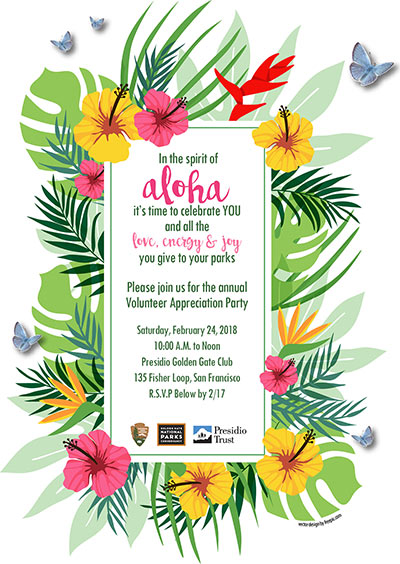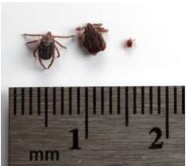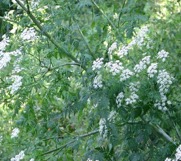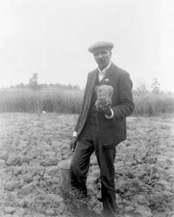|
Dear ,
January came and it went! We have finished planting at Rancho Corral de Tierra (around 4,000 plants this planting season!). MLK Day was a huge success; we had both first-time volunteers and our regular volunteers come out en masse.
If you love the outdoors and want to try your hand at habitat restoration while making a positive impact in your national park, please come out and join us. We’d love to have you!
In This Newsletter:
Volunteer Appreciation Party

Join us for the annual Volunteer Appreciation Party on Saturday, Feb. 24. RSVP here.
From Pumas to Poison Oak: Natural Dangers in Our Parks & How to Handle Them
By Rosie Frederick

|
Mountain Lion. Photo Credit: Parks Conservancy
|
1. Mountain Lions: Don’t run away, stand tall and face the lion directly. Mountain lions often don’t recognize standing humans as prey. Get big—raise your arms and your jacket to appear larger, speaking in a loud, strong voice.
If the lion approaches or appears aggressive, the best course of action is to throw rocks or sticks at the animal until it retreats.1

|
Tick Life Stages. Photo Credit: California Department of Public Health
|
2. Ticks: Although California has a relatively low incidence for Lyme’s disease, this tick-borne disease still exists in the Bay Area. Ticks can also carry several other types of bacteria, viruses, and parasites—including Rocky Mountain Spotted Fever.
Tick season in California runs from fall into winter, so keep an eye out! Remember to wear long sleeves and do tick checks on yourself and your pooch after returning from your time outside. If you find a tick, make sure to disinfect the wound and pry the tick off with tweezers, putting it in soapy water after removal.2

|
Coyote in a Field. Photo Credit: NPS
|
3. Coyotes: Coyotes are found in most of our urban parks, but are rarely a threat to humans. However, although coyotes are naturally timid creatures, living in close proximity to humans can make them bolder. Often, feeding by humans plays a part in this behavior.
If you encounter an aggressive coyote, yell and wave your arms, or throw rocks to “haze” the animals into fearing humans. Always remember to keep small children close and pets on a leash. These native creatures are a natural part of our parks, and discouraging acclimation to humans is one of the best ways we can keep them wild.3

|
Death Cap.
Photo Credit: Daniel Neal
|
4. Poisonous Mushrooms: With the damper weather comes a profusion of mushrooms…some make great treats and others a deadly snack. Remember—unless you have an expert with you, never eat wild mushrooms! Some of the most fatal mushrooms in the Bay Area include the death cap (Amanita phalloides), which sports a white cap and gills.

|
Deadly Galerina.
Photo Credit: Dan Molter
|
Another fatally poisonous shroom in the area is the deadly galerina (Galerina marginata), with its delicate structure and small brown cap. If you have a suspected case of mushroom poisoning, immediately call the Poison Control Center at 1-800-222-1222.4

|
Hemlock. Photo Credit: Kirby Bedon
|
5. Poison Hemlock: Often overlooked as a danger to ourselves and our furry friends, poison hemlock is a very common weed in our parks and also a fatal poison to humans and animals.
The cause of Socrates’ death in lore, the poison can lead to muscle spasms, respiratory paralysis, and even death. Although it takes ingesting significant amount of the plant to be fatal, even small amounts can cause poisoning.
This weed can grow up to 6 feet tall and is often confused with parsley or Queen Anne’s Lace. If you have ingested any amount of poison hemlock, immediately call the Poison Control Center at 1-800-222-1222. 5

|
Poison Oak in Autumn. Photo Credit: NPS
|
6. Poison Oak: A common outdoor concern, poison oak is quite prevalent in the Bay Area. However, while many are likely familiar with its “leaves of three”, it becomes more difficult to identify in the colder months.
A deciduous plant, the poison oak bush drops its leaves in the winter, leaving bare sticks angled at around 45 degrees. These sticks, while leafless, still carry the toxic oils which cause its distinctive rash.
So, beware the bare sticks of the poison oak! If you come into contact with this plant, scrub the affected area with Technu lotion. If a rash develops, use hydrocortisone cream or calamine lotion to soothe the burn.6
Black History Month and Environmentalism
By Camila Fishtahler

|
Georgia Washington Carver holding a piece of soil in a field, 1906. Photo Credit: Library of Congress, Washington D.C (LC-USZ62-114302)
|
It is February, also known as Black History Month in the United States and in Canada. If we take a moment to dig around, it doesn’t take long to find deep connections between scientific inquiry, environmental activism, and conservation in the United States—and the contributions of African American communities.
Much like our country’s history, there is a complicated relationship among people of color and institutions that advocate for environmental protection 1 2 3. From conservationist and sustainability heroes such as George Washington Carver 2 and pioneers in the biological sciences such as Ernest Everett Just 3; African Americans have played a key role in environmental history.
However, it is not uncommon for the successes and efforts of the history of the African American community to be reduced to footnotes, or even left out entirely.

|
| Protesters block the delivery of toxic PCB waste to a landfill in Afton, North Carolina, 1982. Photo Credit: Ricky Stilley |
We credit John Muir with the creation and success of our national park system, but often overlook that Sequoia National Park was only made accessible through the work of the Buffalo Soldiers 4 under the command of Charles Young 5; in which the company built roads into the Giant Forest and Moro Rock as well as constructing the first trail to the top of Mt. Whitney (the tallest peak in the contiguous United States).
It would also be presumptuous to assume that the effects of poor environmental regulation do not disproportionately affect minority communities from the time of enslavement to segregation, and even to this day6.
This struggle for a clean, healthy, and livable environment sparked the Environmental Justice 7 movement (which the EPA suggests ran alongside the Civil Rights movement in the 60’s)8, starting with grassroot organizations and growing to become strong forces in the fight for environmental protection, as well as social change in communities across the United States.
This month we should take the time to honor and celebrate the achievements of Black Americans who are doing some amazing work on environmental issues, as scientists, naturalists, environmental justice advocates, and urban/rural agriculturists. The environmental movement would not have made as great of an impact without their views and voices. Here are just a few:
Mavynee “Beach Lady” Betsch 9 10
Marvyne Elisabeth Betsch, known as “The Beach Lady”, was born on January 13, 1935, in Jacksonville, Florida to one of the most distinguished black families in the southern United States. She earned her nickname through her dedication, fearlessness, and passion to the preservation and protection of American beaches from development and destruction.

|
| Warren Washington and Barack Obama. Image Ownership: Public Domain |
Warren Washington 11 12 13
Warren Washington is an internationally recognized
expert in the field of climatology and atmospheric science, specializing in
computer modeling of the Earth’s climate. He has been honored with many awards—including
membership to the National Academy of Engineering, the American Meteorological
Society (former president), and the American Academy of Arts and Sciences—over
his more than 50 years in the field.
In 2010, President Obama awarded Warren Washington with the
National Medal of Science, the nation’s most prestigious science award. He also
has been recognized for his efforts in mentoring and encouraging young
underrepresented students to pursue careers in atmospheric science.

|
| Majora Carter Photo Credit: Zack Seckler, courtesy of John D. And Catherine T. MacArthur Foundation |
Majora Carter 13 14
Known internationally for her work in urban
revitalization via urban planning, Majora Carter is at the forefront of the
movement. Originally from the Bronx, she founded two nonprofit organizations that
focus on sustainable development and “greening infrastructure”—Sustainable
South Bronx and Green of All.
She is a strong voice in advocating for urban policies
that improve the local economy and environment in underrepresented communities.
Dr. Beverly Wright 14 16 17

|
Dr. Beverly Wright.
Photo Credit: Savetheredwoods.org |
In 1992, Dr. Wright became the founding director of
the Deep South Center for Environmental Justice (DSCEJ) and is known for her
advocacy in the environmental justice arena.
She developed the “Communiversity Model” to instill fair
partnerships between communities and universities, which the DSCEJ uses to
improve environmental integrity in less fortunate urban areas. Her model allows
for the development of action plans— through minority leadership in
environmental, social, and economic justice—that protect the rights of
underrepresented peoples from environmental harm
She has been awarded numerous awards, including the 2008 EPA
Environmental Justice Achievement Award and the National Institute of Science
and the Conrad Arensberg Award, and is recognized by Grios as one of its 100
History Makers in the Making in 2010.
Dr. Robert Bullard 18 19 20
Also known as the father of Environmental Justice, Dr.
Bullard is a highly respected leader, advocate, and academic. A trained sociologist,
he noticed that landfills and incinerators in Houston were disproportionately
located in neighborhoods of color (¼ of Houston’s population at the time were
People of Color), thus sparking his lifelong work in Environmental Justice.
Dr.
Bullard has won numerous recognitions and awards: CNN listed him among the
People You Should Know (2007); Newsweek named him among the 13 Environmental
Leaders of the Century; and the National Wildlife Federation (NWF) honored him
with the Conservation Achievement Award in Science in 1990.
Regular Volunteer Information and Work Day Schedules
Thank you all for
coming out and continuing to come out! We couldn’t do this without you! Here is
the schedule for regular volunteer hours for the month of February. Come hang
out and do some restoration! Regardless if there is a government shutdown, the
volunteer party will still happen. Hope to see you soon!

|
| MLK Day of Service 2018 at Rancho Corral de Tierra. Photo Credit: Frank Morse |
Regular San Mateo Parks Stewardship Drop-In Dates
Saturdays, 10 am–1 pm
Work day events include a combination of hands-on service projects and short natural or cultural history talks. To learn more or sign up, visit our website by clicking here.
Mori Point- February 10
February 17 –
CANCELED (President’s Day)
February 24 - CANCELED (See you at the Volunteer
Appreciation Party!)
Big shout-out
to our regular volunteers and thank you to all who join us!
Sincerely,
Team San
Mateo
Georgia, Rosie, and Camila 
|